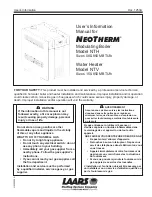
Med Touch Series LCD Alarm Systems
Powerex
•
150 Production Drive
•
Harrison, OH 45030
•
USA
P 1.888.769.7979
•
F 513.367.3125
•
www.powerexinc.com
IN597400AV
•
08/2016
Page 6 of 56
Alarm Installation
Installation of the Powerex alarm involves installing the rough-in
box, the risers & the transducers (if it is an area alarm or combination
alarm) and front panel and making the necessary conduit, plumbing
and electrical connections. All installation and testing should be done
in accordance with NFPA 99 or CSA Z7396.1.
Electrical power intended for the alarm to
be installed should be disconnected prior to
installation.
This device should only be installed by qualified
personnel. Installation should not be attempted by
anyone not having general experience with the installation of devices of
this nature.
Rough-in Box Installation
This is a rough-in box for a
combination alarm. Your rough-
in box should look the same or
similar to this unit. The risers are
shipped loose, for protection during
shipment, and must be installed.
If transducers are to be mounted
remotely, it is recommended that
they be connected to the DISS
demand check valves installed in
the corresponding zone valve box
equipped with the Powerex E Z
Backfeed™ and E Z Find™ features.
Refer to the building plans to determine the location of the alarm.
The contractor is to provide rigid
mounting that will support the
alarm box on both sides. The metal
flanges provided on both sides of
the rough-in box are to rest against
the rigid mounting brackets. Screws
(contractor provided) are to be
driven thru the holes in the metal
flanges into the mounting brackets.
Flanges are adjustable to allow for a
drywall depth of 1/2” to 1 1/8”.
Mount alarm rough-in box so it will
be flush or just below the finished
wall surface using the adjustment
feature on the flanges.
Side/end view of rough-in back box
The power supply hole is located in the bottom (left side) of the
rough-in box. Remove the plaster cover and panel covering the
power supply. Make conduit connections for wiring from the facility
emergency power source.
To remove the power supply cover, loosen the two screws at the
top of the cover and slide the cover to the right, then lift the cover
over the screw heads. Slide the wiring harness strain relief to the left
until it is free from the cover.
Wiring
Use either of the two ½” conduit knock-outs provided on the lower
left side and bottom of the rough-in box to route conduit to supply
either 120 or 240 VAC to the power supply.
Note:
Separate conduit
should be used for low voltage wires (use knock outs provided on the
top of the box). Low voltage signal wiring must be run at least 6 inches
away from high voltage wiring (90VAC or greater)
When necessary to cross low and high voltage wiring, maintain
minimum 6 inch spacing and cross as close to 90° as possible.







































